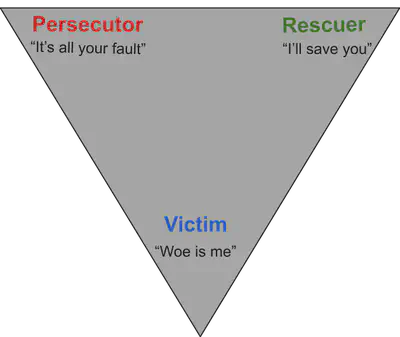Where There's Smoke, There's Fire! Understanding the Drama Triangle
Remember that time when you were in that one super confusing, dramatic social situation? When that one person did that one odd thing, and that one dude said something you couldn’t believe, and you got pulled into it? Or think about all those reality tv shows and soap operas you’ve seen that are dripping in drama. Or the funky, smoky dynamics that occur with people at work or with a loved one… Well, certain personality structures/disorders are prone to drama…but what is drama? And why is it called a Drama Triangle?
♫ insert dramatic music ♫
Where Did the Drama Triangle Come From?
The Drama Triangle came about after WWII when mental health professionals noticed that family factors played a part in the mental health of soldier’s reintegration into their family systems. Eric Berne, a psychiatrist during that time, believed social interactions contributed to an individual’s psyche, and he created a theory called Transactional Analysis. (This led to lots of other theories focused on family dynamics, including Murray Bowen’s concept of triangulation). Then we have Stephen Karpman, an actor turned psychiatrist, who studied under Eric Berne. Karpman was the one who coined the term and theory of the Drama Triangle in 1968. And we’re still using it 50 years later, especially in understanding personality disorder dynamics!
What is the Drama Triangle?
Karpman’s experience with theater drama led to his understanding of relational interactions (especially conflict) in terms of a triangle. The Drama Triangle includes power and destructive dynamics in the roles that people play in their interactions, as well as the possibility of people shifting roles. And, because it is a triangle with three sides, it focuses on three roles.
Players in the Drama Triangle
Victim
The most important thing to understand about the victim role is that it is not synonymous with being an actual victim. Instead it’s someone who is feeling or acting like one. Their attitude is “poor me” or “woe is me,” a masochistic stance that pulls others to “save” them because they think they can’t take care of their own needs.
Persecutor
Again, it’s important to know that the persecutor role does not necessarily mean that the person is a villain, but that they take on the villain role OR are cast into the role by others. The persecutor’s stance is, “It’s all your fault, and it’s all about my needs.” Sometimes, this can be sadistic by lashing out or transferring blame or pain onto others. But other times, a person in the victim role can cast a person who doesn’t agree with their pain as a persecutor even though there’s no wrongdoing.
Rescuer
The rescuer role is the perceived rescuer, but they are oftentimes enmeshed enablers, taking the stance, “Let me help you.” There can be a sense of guilt if they don’t rescue, perhaps tied to being a “fixer” in childhood, avoider of their own problems (projection), or a narcissistic need to save another with their specialness.

Additionally, since nothing in life and relationships is simple, people don’t just stay in one role. People can move all around the triangle, which creates so much complexity and chaos! Different personality types usually have different patterns. For example, antisocial types tend to be in the persecutory role, but can also move into a victim role. Paranoid structures can move all over the three roles. Dependent types tend toward the victim role but can switch to the persecutory role. Narcissistic structures can be in the persecutory role and switch to rescuer.
| PUBLIC SERVICE ANNOUNCEMENT |
|---|
| You’re setting yourself up for failure to think you can change anyone, no matter what role. If your happiness is contingent on someone else, you’re not going to find it. |
Stop, Drop, and Roll
So to detach from the drama dynamics and get out of the fire, you have to stop, drop, and roll.
Stop
The first step is to stop and observe what’s happening. Listen to your gut and acknowledge any confusion, cloudiness, fuzziness, lack of clarity, or chaos. Are you questioning reality and second guessing? Do you smell the smoke? Zoom out to see the big picture, like nonverbals and transactional behaviors. Stop and recognize that you’re in a drama, then figure out if you’ve taken on or been cast into a certain role.
Drop
The second step is to drop away from the fire. You’ve already figured out the players, so try to figure out what everyone is getting out of the dynamic so you don’t fuel the fire. Disrupt anything that reinforces the dynamic. Create and keep boundaries!
Roll
The third step is to roll out of the fire and into safety. Remove yourself from the triangle if possible. This might be anywhere from taking space for an hour (if it’s a mild dynamic) to completely getting out of the relationship (if it’s unsafe/abusive).
The main point of all this is to decrease the drama in your relationships, because let’s face it - it’s exhausting. So when you feel the funk in your interactions with others and smell something smoky, remember, where there’s smoke, there’s fire.


